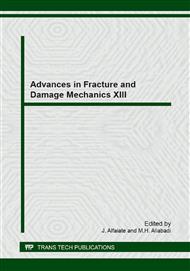p.297
p.301
p.305
p.309
p.313
p.317
p.321
p.325
p.329
Application of Acoustic Emission for Identification of Differences in Fatigue Damage of Selected Materials for Power Plants
Abstract:
An acoustic emission is remarkable source of information about the fatigue process and its intensity under cyclic loading. Specimens made of reactor steel and INCONEL 713LC were subjected to bending fatigue loading in the high-cycle range. This study presents results of acoustic emission signal analysis. The main aim of this study is to propose a methodology for evaluation of the early manifestations of fatigue damage and to identify material changes in both materials by AE parameters. Signal comparison material indicates differences of damage mechanism in observed. An examination of crack initiation sites and microstructure has been also performed.Experiments were realized in cooperation between laboratories of Brno University of Technology and University of West Bohemia in Pilsen and its related to solving of project of the Czech Ministry of Industry and Commerce: “A diagnostic complex for the detection of pressure media and material defects in pressure components of nuclear and classic power plants“ and project New Technologies for Mechanical Engineering (NETME +).
Info:
Periodical:
Pages:
313-316
Citation:
Online since:
September 2014
Authors:
Price:
Сopyright:
© 2015 Trans Tech Publications Ltd. All Rights Reserved
Share:
Citation:


